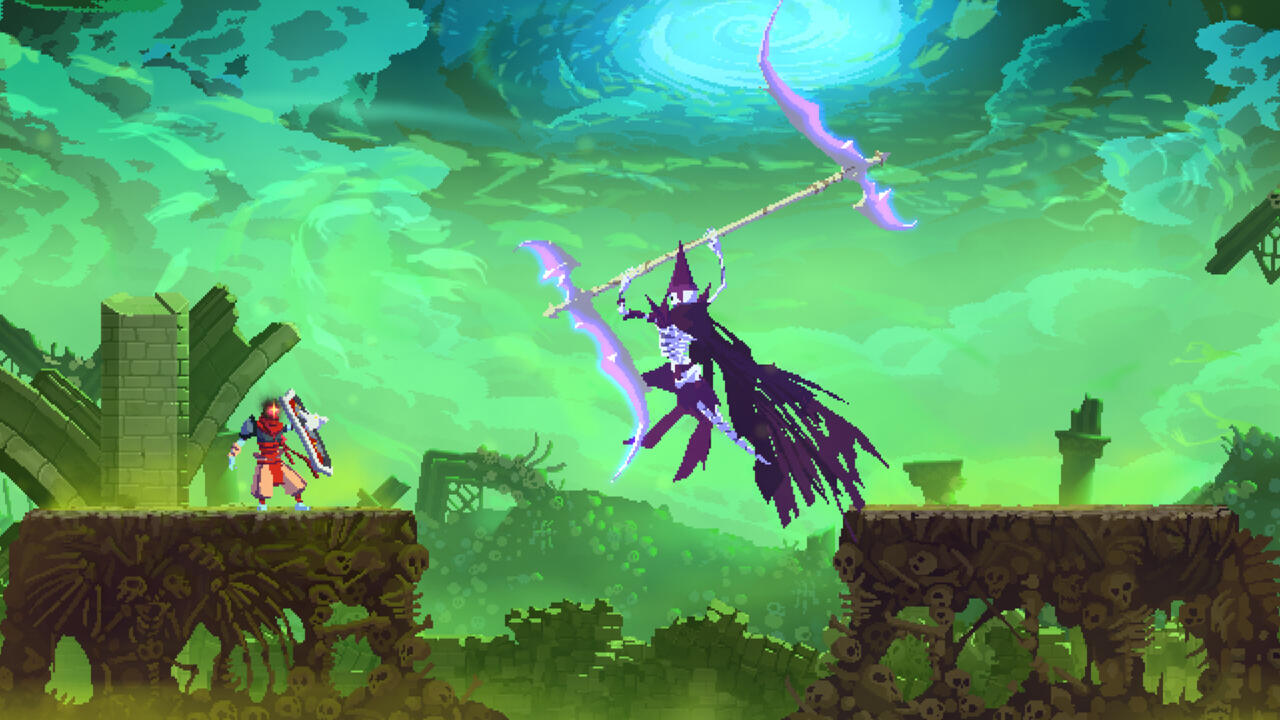I loved Dead Cells, but it never struck me as particularly Castlevania-like. The acclaimed action roguelike from Motion Twin certainly had some passing resemblance in some of its combat mechanics, but not so much that I ever made any association to Konami's vampire-hunting franchise. So when the studio announced it was making an expansion modeled after Castlevania, I was certainly intrigued, but also surprised. How would that work, exactly? Pretty well, it turns out, as Dead Cells: Return to Castlevania is a clever fusion of Castlevania homages and Dead Cells' structure, and helps to illustrate how Castlevania DNA has been a part of Dead Cells all along.
The similarities between the two are cut into stark relief by their differences. Castlevania, and especially the Symphony of the Night sub-genre that serves as the basis for most of this expansion, is an exploration-based action game, with a castle full of tightly-knit secrets and clockwork-like precision to its progression gating. Dead Cells very much isn't that, as its roguelike biomes mix and match different pieces like Lego bricks. You'll recognize certain pieces after you've played it enough, but it will always be impossible to draw a consistent map or to tell a friend exactly where to find a secret key. In this regard, they couldn't be more different.
So the blending in Return to Castlevania can best be described as Dead Cells doing its best Castlevania impression. The Castlevania biomes are still randomized in the roguelike style, but the pieces do feel more oriented around puzzle-solving and secrets than in the main Dead Cells game. In fact, that's one of Return to Castlevania's most impressive tricks--it's still built around interlocking pieces, but the more secret-solving components don't feel contained to small, individual parts. It's almost as if the game is building a fresh, albeit relatively small, Castlevania map every time you respawn.
The most recognizable homages, though, come in the form of new enemies and weapons. Those enemies range from the lowly Fish Man to hulking armored knights and, naturally, a confrontation with Dracula himself. You'll almost immediately find renowned sub-weapons like the Cross and Holy Water while making your way through the castle, and once you've unlocked them, they'll be available for upgrading with modifiers, like any other piece of equipment in Dead Cells. Seeing combat against familiar enemies with recognizable weapons really drives home how Dead Cells' remarkably satisfying combat has always felt like the best moments of Castlevania.
The story is slight, consisting mostly of characters like Richter or Alucard showing up for a quick chat about where to find Dracula, but it's serviceable and helps point you in the right direction. The spirit is playful, with the Prisoner shrugging and thumbs-upping his way through this wild new adventure full of video game royalty. A few story moments reward you with powerful new primary weapons or skins modeled after Castlevania heroes, and wearing these skins even leads to certain characters recognizing and talking to you as if you were, say, Simon Belmont.
Some of the best cinematic moments aren't story-related at all, but rather when you stumble upon some hyper-specific Easter egg referencing a moment in Castlevania history. At one point I sat and watched the ghostly dancers twirl around the screen for minutes, hypnotized, before eventually realizing the scene would go on forever if I let it.
This being Dead Cells, it's also remarkably tough. Dead Cells was already known for its challenge, and Return to Castlevania felt slightly more difficult than the main campaign. That means it's ideally suited for experienced Prisoners seeking a new challenge, but it doesn't need to be relegated to endgame content. That's because the Castlevania content itself gives you such a steady stream of powerful new equipment that you don't necessarily need to wait for the stars to align with a run that gives you a good build.
The fresh batch of weapons is also inventive in new ways that both fit within the Dead Cells milieu while also feeling iconically Castlevania. The weapon you get for defeating Death, for example, creates an electrifying rush to combat, encouraging you to pick off weaker enemies to empower you against stronger enemies.
All of this makes Return to Castlevania an excellent little taste of Castlevania within the framework of Dead Cells, but it's only a taste. This is an expansion, after all, so it adds a few new biomes that, all put together, would make up only a fraction of the map space of a typical Castlevania game. It's also mostly straightforward, rather than requiring the traditional backtracking to open new paths with additional powers. The expansive scope of a sprawling environment is part of Castlevania's core identity, so its absence is a reminder that this is still Dead Cells with a Castlevania flavor. Depending on your luck and skill level, it will take a few hours to explore the content and reach Dracula, and probably a couple more to find and unlock all of the new gear.

It's also a Dead Cells expansion in that there are no easy shortcuts. This is a roguelike, after all, so even once you know the secret to finding Dracula's inner sanctum, it will take a good bit of legwork to get there. If you die--for example, against the challenging final battle with Dracula--you'll need to do it all again.
Those qualities are part and parcel of this being an expansion to Dead Cells. It retains its own core identity, so the smaller randomized biomes and lack of shortcuts are just part of its nature. Those don't feel especially reminiscent of Castlevania, but the whole expansion is imbued with Castlevania flavor. Dead Cells: Return to Castlevania is a smart, frenetic fusion of a modern action-roguelike and classic gaming royalty.